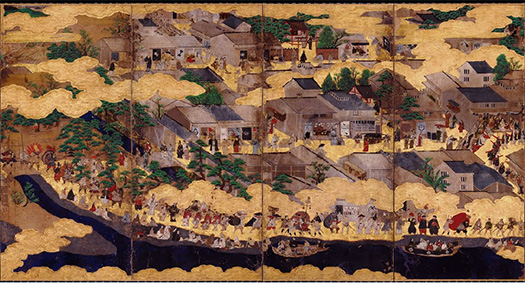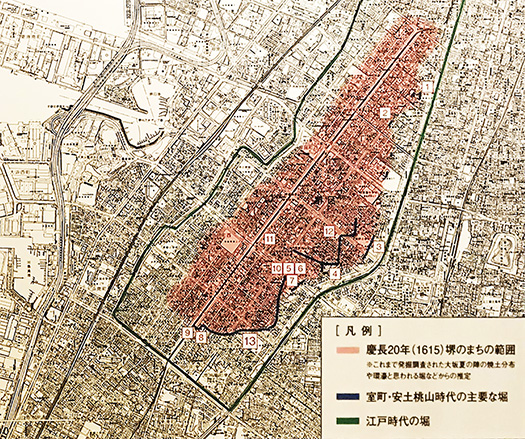

「いい家シリーズ」今回は特別篇で中世都市・堺です。
関西に1週間ほど出張機会がありそのときどこに宿泊しようか考えて
真っ先にアタマに浮かんだのが堺の町です。
織田信長が青春期に堺に旅行していたのではないかと
多くの歴史好きが想像を巡らせることが多いと言われます。
中世的な経済、コメ生産高に基盤を置いた群雄割拠の時代から
ポルトガル、スペイン、イスパニアといったキリスト教国主導による
大航海時代という交易商業時代が日本に押し寄せてきて
その畿内地域の受け入れ港として堺の町は歴史の表舞台に登場する。
若いときの奇行で「かぶきもの」と呼ばれた感受性の持ち主信長にすれば、
京都の権威主義ではなく、堺の自由闊達な空気の吸引力が強かったに違いない。
祖父信定・父信秀は、尾張の自由貿易港を支配することで経済覇権を握り、
結果として同族内での争闘を勝ち上がって尾張を統一したと言われる。
1543年には社前町の商業地支配利権からと思われる朝廷接近策として
「内裏築地修理料」四千貫文を献上というのは有名な話。
<貨幣価値はだいたい600人を1年間雇えるくらいの金額という説>
それまでの「都市」は政治的動機での成立が多数派。
最初の首都建設・奈良から京都、鎌倉といった政治都市が主流だったのに、
政治とは縁遠い成り立ちの都市が歴史の脚光を浴びて登場。
足利将軍家15代の義昭を奉じて信長は京都に覇権を樹立したが、
その義昭から報償として「副将軍にする」と言われたのを辞退し
代わりに堺に代官を派遣する、地域支配権を求めたというのは、
織田家の重商主義的志向性があきらか。
土地支配に軸足を置かない政経思想を持った革新派が織田家だったのでしょう。
そういう織田家だからこそ堺は歴史の主舞台に登場したとも言える。
日本の経済大動脈は瀬戸内海交易ルートの海運地域ですが、
そういう経済根拠地の中でも、堺は群を抜いていた。
日本の心臓部・畿内と海外交易のメイン動脈の一大港湾都市。
海上交易は日本史の大きな要素を占めているのになかなか表舞台には出ないけれど、
堺衆という資本家たちがはじめて歴史の主舞台に個人として登場する画期。
上の写真は「住吉祭礼図屏風」(堺市博物館収蔵)。
〜住吉祭は大阪の住吉大社の神輿が堺にある御旅所まで約7キロメートルの
道のりを渡御し夏の疫病などを祓う祭礼。江戸初期の表現様式を持つこの屏風は、
商家が並ぶ堺の町で賑やかに繰り広げられる住吉祭のようすを描いている。 〜
戦国期を越えて江戸体制が固まった時期の堺の様子が活写されていて
わたしの大好きな屏風絵の一枚です。
・・・ということで、いい家シリーズ特別篇として人間居住の大要素「都市」環境を
いい町として考えてみたいと思う次第です。
この屏風絵にはたくさんの家も描かれているので、面白いのですね。
English version⬇
[Japanese good town “Medieval Sakai” / Japanese good house special edition ㊱-1]
“Good house series” This time is a special edition of Sakai, a medieval city.
I have a business trip opportunity in Kansai for about a week and think about where to stay at that time
The first thing that came to my mind was the town of Sakai.
I think Oda Nobunaga was traveling to Sakai during his youth.
It is said that many history lovers often imagine.
From the medieval economy, the era of group male division based on rice production
Led by Christian countries such as Portugal, Spain and Ispania
The trade and commercial era of the Age of Discovery is rushing to Japan
The town of Sakai appears on the front stage of history as a receiving port in the Kinai area.
For Nobunaga, who has a sensitivity called “Kabukimono” because of his eccentricity when he was young,
It must have been Sakai’s free and open air suction power, not Kyoto’s authoritarianism.
His grandfather Nobusada and father Nobusada seized economic hegemony by controlling Owari’s free trade port.
As a result, it is said that he won the struggle within the same family and unified Owari.
In 1543, as a measure to approach the imperial court, which seems to be from the commercial land control interest in Maemachi.
It is a famous story to give 4,000 pieces of “Dairi Tsukiji repair fee”.
Until then, the majority of “cities” were politically motivated.
Political cities such as Kyoto and Kamakura were the mainstream from the first capital construction, Nara
A city far from politics has emerged in the limelight of history.
Nobunaga established hegemony in Kyoto in honor of Yoshiaki, the 15th generation of the Ashikaga Shogunate.
He declined to be told by Yoshiaki to “become a deputy general” in return.
Instead of sending a deputy to Sakai, he asked for regional control.
The Oda clan’s mercantilist orientation is clear.
The Oda clan was probably an innovator with a political and economic ideology that did not focus on land control.
It can be said that Sakai appeared on the main stage of history because of the Oda clan.
Japan’s economic aorta is a shipping area on the Seto Inland Sea trade route,
Sakai was by far the best among such economic bases.
A major port city of the main artery of foreign trade with Kinai, the heart of Japan.
Maritime trade is a big part of Japanese history, so it’s hard to come to the front stage,
An epoch-making period in which capitalists named Sakaishu first appear as individuals on the main stage of history.
The photo above is “Sumiyoshi Festival Folding Screen” (Sakai City Museum collection).
~ The Sumiyoshi Festival is about 7 kilometers from the Otabisho where the portable shrine of Sumiyoshi Taisha in Osaka is located in Sakai.
A festival that goes a long way and worships summer plagues. This folding screen with the expression style of the early Edo period
It depicts the lively Sumiyoshi Festival in the town of Sakai, where merchant houses are lined up. ~
The state of Sakai during the period when the Edo system was solidified beyond the Warring States period is captured live.
This is one of my favorite folding screen paintings.
… So, as a special edition of the good house series, a major element of human residence, the “urban” environment
I want to think of it as a good town.
Many houses are drawn in this folding screen picture, so it’s interesting.
Posted on 7月 5th, 2021 by 三木 奎吾
Filed under: 住宅マーケティング, 歴史探訪







コメントを投稿
「※誹謗中傷や、悪意のある書き込み、営利目的などのコメントを防ぐために、投稿された全てのコメントは一時的に保留されますのでご了承ください。」
You must be logged in to post a comment.